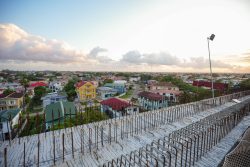Dear Editor,
Stabroek News recently carried an article (February 13), an editorial (February 14) and a letter (February 14) relating to the Hope Canal and the East Demerara Water Conservancy (EDWC). In all three cases, a number of misrepresentations were made. I am not in a position to determine whether these were deliberate misrepresentations or misrepresentations made through ignorance. I, therefore, would like to present the facts.
1. Misrepresentation: The SN editorial states that the government “has had a full seven years [from 2005] – almost to the day – to complete the lynchpin in its plan – the Hope Canal”
Fact: The idea of a relief channel was first recommended in a report of technical assessments of the EDWC in 2004-05. Subsequently, a number of internal consultations took place and the feasibility of such a project was considered. Discussions about funding the construction of a relief channel also took place. In 2009, President Jagdeo announced that the idea of a northern relief channel must be accepted and instructed that public consultations must start. President Jagdeo announced also that the government would mobilize the resources for the construction of the northern relief channel in its 2010 Budget Estimates. The project was seen as a long-term solution to flooding in these areas during high intensity rainfall caused by climate change. The Hope project commenced in October 2010 after the contract for the design was completed in 2009. SN is aware that construction did not start seven years ago. An idea was born in 2004, it was discussed and its feasibility considered by experts and the possible funding for such a project was pursued. In 2009, the idea of a northern relief channel was transformed into a project and a design was pursued. Just three years after an idea was converted into a project by the experts, the Government of Guyana had a design done, sourced the funding and begun the construction of the northern relief channel at Hope. It is expected that this channel would be completed in 2013.
But the northern relief channel is only one of the initiatives undertaken by the PPP/C government to enhance the drainage and irrigation system in Guyana and to improve and adapt the EDWC in response to the ever-increasing risks posed by climate change and extreme weather conditions in Guyana. In regards to the EDWC, since 2005 to present, works have been undertaken and completed under the Taskforce Infrastructure Recovery Programme and ongoing under the Conservancy Adaptation Project (CAP) to improve operations in the EDWC. Under the CAP project, the Lama, Kofi and Cunha outlets have been rehabilitated and equipment such as a pontoon and excavator have been bought to add to the fleet to maintain perimeter channels and waterways and reinforce vulnerable sections of the conservancy dam.
Some of the major works undertaken on the EDWC over the last few years are the rehabilitation of the Cunha relief channel, construction of a revetment at Cunha, the dredging and cleaning of waterways including those in the Kofi and Cunha channels, the leasing of maintenance equipment, the rehabilitation of inlet and outfall channels at Land of Canaan Five-door sluice, the rehabilitation of the Kofi sluice and constructing the access road to Flagstaff. Also a newly rehabilitated Kofi relief channel was put in place as well as the construction of a CNC regulator. Additional works included the construction of an intake structure at Enmore, the installation of a new door and lifting mechanism at the Kofi sluice, construction of scour protection at Kofi, 200 feet revetment at Shanks, EDWC, construction of nine miles of upstream conveyance channel at Kofi and the re-activation of 10.5 miles of Annandale waterpath and buttressing of embankments. In excess of $500M has been spent from 2007 to the present to upgrade this facility. And there are several initiatives in the pipeline to further improve the operation and safety of the EDWC and reduce the risk of opening the Maduni and Lama.
2. Misrepresentation: The assumption that “Seven years later the project is plodding on and 2014 might arrive without it being completed” –
Fact: The construction of the northern relief channel at Hope and its associated structures started in 2010 and not 7 years ago as the SN suggests. The project will be completed in 2013 and we are confident, even with any slippage, that it would be functional in 2013 and not 2014. The conclusion by SN is reckless, if not mischievous.
3. Misrepresentation: The SN published a letter on February 14 that asserted “the threat posed by the EDWC” is a result of “siltation and poor management for the past 30 years,” that key sections of the northern dam are weak and can give way, that “cycles of intense climate changes have led to slippages and lowering of dams” and that internal channels and outlets west are not properly cleared and operating at full capacity.
Fact: These assertions are baseless, reckless and provoking. The facts are that there has been no major overtopping or breach of the EDWC since 2005. In 2008-09 it was reported that the amount and intensity of rainfall recorded in Guyana had increased dramatically, exceeding levels experienced in 2005 but there was no disastrous outcome because of enhanced drainage works, primarily in the EDWC. Indeed, the rainfall amounts between January 28 and February 6, 2012 were among the highest recorded in history, along with 2005 and 2008-09. Yet, there was absolutely no breach or overtopping of the EDWC dams. The facts are that the dams of the conservancy channel are far more secure today than at any time in the last 40 or more years and the holding capacity of the channel is at the highest ever in the history of the EDWC. These improvements were noted and were commended by the World Bank in its Rapid Assessment Report on Flood Related Damage to Coastal Guyana in January 2009. The report stated that this was accomplished largely through the implementation of a concerted maintenance and rehabilitation programme. The facts do not support any of the statements in this letter. These statements are either made out of total ignorance or the intentions were to deliberately mislead people.
4. Misrepresentation: The assertion in its editorial that “if the Hope Canal is completed and provides another outlet north to the Atlantic it will only be a matter of time before the ever decreasing holding capacity of the conservancy and its clogged internal drains lead to another challenge or weakened dams give way under localized pressure.”
Fact: SN in its own confusion sought to confuse its readers. There is inherent contradiction in the editorial since the editor in one instance wants the canal to be completed “properly and rapidly,” but on the other hand is questioning the need for the canal. It seems as though the editor is presuming a negative and disastrous outcome for the EDWC northern relief channel at Hope/Dochfour even though he has no knowledge or technical basis for making such a presumption, since hydrological study of the EDWC northern relief channel has indicated that this structure will add to the conservancy’s ability to drain and will reduce the risk of opening the Maduni and Lama sluices, thereby reducing the risks to populations in Mahaica, Mahaicony and Abary.
5. Misrepresentation: The SN claims that two agriculturally based areas, Canals Polder and Black Bush Polder, have “bungled drainage infrastructure.”
Fact: There is no “bungled drainage infrastructure.” It is true that the drainage system is inadequate at this time. This was recognized since the construction and establishment of the Canals Polder more than 50 years ago. After independence, Guyana did not improve the drainage capacity of this important area and, instead, allowed what we had to deteriorate and disintegrate. Since 1992, significant investments have been made to improve the drainage system in the Canals Polder. The Canals Polder will soon benefit from a new canal and associated structures along with a pumping station to enhance drainage. At the mentioned meeting with NDIA officials and farmers, this new channel was discussed with residents, along with the consultants who are formulating the design. It should be noted that the Canals Polder is the beneficiary from a major project, the Agriculture Export Diversification Project which is 72% completed at this time.
Two years ago, new drainage pumps were installed at Stanleytown. Since then, government has continued to implement drainage programmes and review, with the objective of improving efficiency in drainage.
Under the Agriculture Support Services Project (ASSP), drainage and irrigation structures have been rehabilitated in Black Bush Polder. The east Black Bush area would also benefit from a new northern channel at Johanna, a new sluice and pumping station under the same programme that would enhance drainage significantly. This would eliminate the need for drainage water from Joanna to be drained through the Yakusari drain and through the #43 sluice.
What we have is not a “bungled drainage infrastructure” at Canals Polder or Black Bush Polder, but a concerted effort to improve what we have and to add to the drainage infrastructure to enhance the capacity for drainage in these polders.
6. Misrepresentation: The letter in SN of February 14 sought to give the impression that nothing has happened with the Conservancy Adaptation Project (CAP) by posing the question “What was the outcome of the US$2.7M consultancy contract on the conservancy?“
Fact: The truth is much has happened with the CAP. Under the CAP, the additional upgrading of water control structures has been undertaken, including the restoring of the Kofi outlet and, in a limited way, the reopening of the Cunha outlet into the Demerara River. Rehabilitation of the Lama sluices has also been completed. Equipment such as a pontoon and excavator has been bought. Significant progress has been made in the consultancy. This includes LIDAR and orthophoto of project area done and sent to Dewberry for them to provide expert review; hydrological equipment bought and installed in conservancy and pertinent creeks; required geotechnical testing for EDWC embankment safety identified; and completion of preparations to start the transect surveys.
These studies will last until 2013 with 35% of the project completed at this time.
Yours faithfully,
Leslie Ramsammy
Minister of Agriculture





